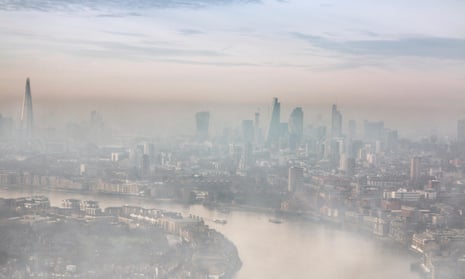Wednesday morning, my clean air partner and I approach a coach unloading children outside the Barbican Centre in London. The driver is helping to marshal the kids across the pavement and has left his engine on while parked.
We introduce ourselves as volunteer air quality wardens and ask him to turn it off. He immediately agrees, cuts the ignition and joins us for a chat. We hand over an air freshener as a thank you, with the message “you are the key to cleaner air”.
Next up is a lorry delivering scaffolding, parked up and engine off. We thank the driver and hand over another air freshener.
Over the course of the morning we talk to around 30 drivers. All but the odd one turn their engines off straight away and promise to do so every time in the future. In the last year only one driver has refused to turn off; no one has been abusive.
It is illegal to leave an engine idling and the City of London Corporation can issue fixed penalty notices to drivers who continue to run their engines while parked, but campaigns are much more effective at changing behaviour in the long term. More effective still is to use volunteers like me, who live or work locally.
The corporation began using local volunteers in 2013, with a year-long air quality monitoring programme. More than 100 residents in the Barbican estate recorded nitrogen dioxide (NO2) and fine particle levels on their balconies, and on walks to work, school or the shops.
Our research showed that in many streets nitrogen dioxide levels breached EU limits. Beech Street, just across from the Barbican, was one of the worst in the capital, with NO2 levels more than double the annual mean limit. London as a whole breached its annual air pollution limits just five days into 2017.
This is nothing short of a public health emergency. Carbon monoxide, nitrogen dioxide and particulate matter are extremely damaging to our health, and idling engines emit unnecessary pollutants. If a vehicle is idling it can produce up to twice as much exhaust emissions as when it is moving.
The vehicle idling action programme aims to reduce Londoners’ exposure to these emissions by getting drivers to turn off their engines when parked. The corporation has been running the campaign locally since 2015, and last year action days were rolled out across 14 additional boroughs with the support of the Mayor’s air quality fund.
Volunteers are given a couple of hours training on how to approach drivers in a friendly and non-confrontational way. We are then sent outside schools and hospitals, in residential areas and on roads known for engine idling. Each volunteer works with a partner: one person engages the driver, the other records what happens – whether the driver turned their engine off when asked or whether it was already switched off; what type of vehicle they were driving; where it was parked.

We’ve found that drivers are far more likely to engage with volunteers who live or work in the local area than with a uniformed traffic enforcement officer. Many drivers don’t realise they are parked close to a nursery or primary school or a hospital, and that just turning their engine off can have a transformative impact. A couple of minutes chatting with a volunteer may reveal that the driver has a child with asthma, or a family member with respiratory problems. Empathy and personal experience help raise awareness and result in lasting change in behaviour and attitudes.
In 2016 the local authority created a low emission neighbourhood (LEN) in the Barbican and Golden Lane area, leading to a raft of measures to improve traffic management and encourage the use of electric vehicles. Volunteers who live or work in the LEN have also taken the initiative to create several pop up clean air gardens, with air quality enhancing species. We also shared our air quality results with local businesses, who signed up to an air quality pledge to reduce their emissions.
Support comes from some surprising sources: a black cab driver on a break (engine off), who is counting the weeks before he can buy an electric taxi; a coach driver who tells us that head office will message him to turn off his engine if it runs for more than a few minutes; a group of construction workers giving us the thumbs-up after an eye-opening discussion about pollution levels outside their site. We are changing long term behaviour, not just getting drivers to switch off when caught in the act.
Thursday 15 June is National Clean Air Day
Sarah Hudson is a resident of the City of London and a volunteer clean air warden
Talk to us on Twitter via @Gdnvoluntary and join our community for your free fortnightly Guardian Voluntary Sector newsletter, with analysis and opinion sent direct to you on the first and third Thursday of the month.

Comments (…)
Sign in or create your Guardian account to join the discussion